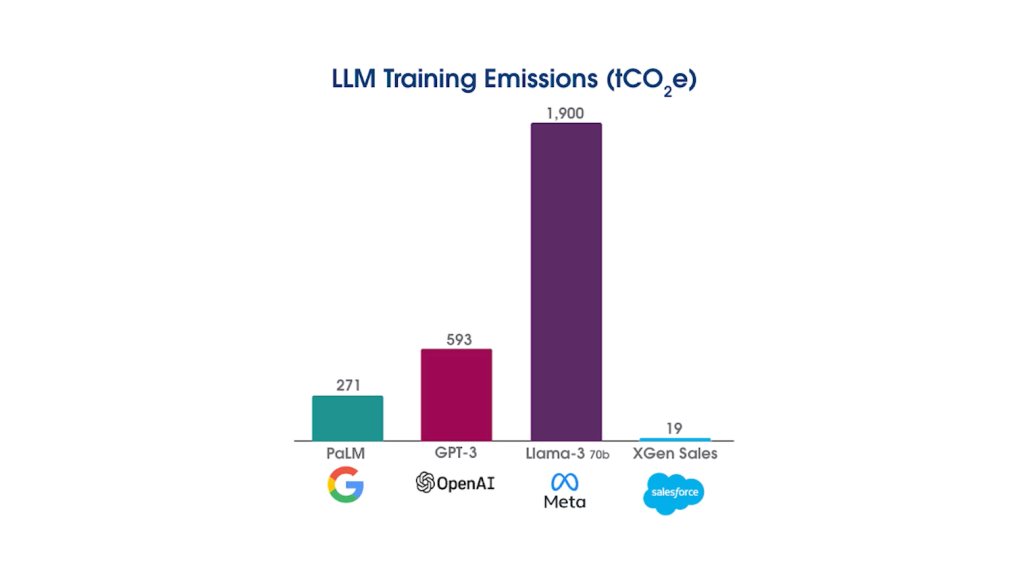A recent Salesforce survey revealed that 65% of sustainability professionals believe their company needs to balance the benefits of AI with its environmental costs. If built and used without care, for example, the technology can contribute to spiking energy usage that can increase carbon emissions and exacerbate the climate crisis.
These same professionals are also optimistic about using AI to aid in their sustainability efforts. AI can augment the sustainability workforce by taking on tasks to quickly analyze complex datasets to reduce energy consumption and even address threats to ocean health.
And yet, only 20% of these professionals have worked AI into their regular business practices — reporting they aren’t yet sure how to use this powerful technology.
As our planet faces a dire climate crisis, there’s no time to wait. We sat down with Boris Gamazaychikov, Senior Manager of Emissions Reduction at Salesforce, to hear how the company is striking the all-important balance between AI’s challenges and its solutions, and how his team is using AI to help move sustainability efforts forward — before it’s too late.
Q. AI usage is rapidly expanding as technology becomes more advanced, but many don’t realize the environmental impact it can have on the planet if not managed properly. Can you tell us why some climate experts are concerned about AI’s growth?
AI is a catalyst for increased power demand because training large AI models, especially large language models (LLMs), can be extremely energy-intensive. For example, training an LLM like GPT-3 can consume as much energy as 130 homes would use in a year. Once trained, running AI models also requires energy, which can eclipse the initial training impact, especially if the models are used at scale.
AI runs primarily on cloud data centers across the world, where specialized hardware demands immense computational resources, resulting in substantial energy consumption and water usage.
The electricity needed to power data centers often emits carbon because in many parts of the world that power is supplied by fossil fuels like coal and natural gas. And while companies including Salesforce are encouraging and even requiring the use of renewable resources like solar and wind to power these assets, AI’s rapid growth means the demand for those resources is outpacing the current supply.
Q. How is Salesforce making its AI solutions more sustainable?
There’s a race in the industry to create bigger models that can unlock the next wave of AI capabilities. The reality is, however, that these models require a massive amount of energy, and it’s not always necessary to use the biggest, most powerful model for specific enterprise needs. That’d be like using a semi-truck to go get groceries or pick up a single passenger. That’s why our Salesforce AI Research team develops efficient task- and domain-specific models that can be used for CRM applications — greatly reducing the energy and compute required to accomplish specific tasks.
For example, the team developed xGen, the world’s first LLM for CRM. It generates call summaries that offer sales reps contextually relevant insights and recommendations to enhance productivity and effectiveness.
These are very specific CRM use cases to limit energy usage — it’s also trained on relevant data, so users are less likely to get inaccurate results. Because of its compact size, training xGen resulted in significantly less emissions than many other models, as well as making it more energy-efficient to use.

While choosing smaller, domain-specific models makes the biggest difference, choosing low-carbon data centers can also play a role in reducing impact. Data center emissions vary widely depending on how much fossil fuel is being used to power them.
To reduce AI model emissions, Salesforce trained its models in lower-carbon data centers powered by electricity that emits 68.8% less carbon than global average electricity. This resulted in 105 fewer tons of carbon dioxide equivalents (tCO2e) than if data centers with global average carbon intensity were used for training.
Q. How is Salesforce using AI to accelerate its sustainability initiatives?
Our data center infrastructure team uses AI to predict and anticipate our customers’ usage patterns, automatically scaling the volume of servers required. This allows us to tailor the way our data center infrastructure is used so we don’t waste excess energy. This automated application saves time, reduces carbon emissions, and ensures that our products are running smoothly for our customers.
This automated application saves time, reduces carbon emissions, and ensures that our products are running smoothly for our customers.
Boris Gamazaychikov, Senior Manager of Emissions Reduction at Salesforce
AI is also helping us perform sophisticated forecasting of our own carbon emissions by analyzing millions of data points from our supply chain, business travel, data center infrastructure, real estate, and more. These insights help us make better, smarter decisions as we work to reduce our emissions. And, we’ll soon be able to bring this same functionality to customers through Net Zero Cloud.
We’re also using AI to help our customers improve the efficiency of their Salesforce deployment. Since Salesforce is so customizable, users can tweak it in a lot of different ways that are use-case specific. We’re using an internally developed LLM called CodeGen to analyze the code base and provide automatic suggestions that improve efficiency through the Apex Guru feature of Scale Center. The latest version of CodeGen 2.5 is optimized for efficiency, with multi-epoch training and flash attention, performing as well as larger models at less than half the size.
Q. What metrics or KPIs does Salesforce use to measure the sustainability impact of AI initiatives?
The first important KPI is related to an AI model’s training. Both the energy and carbon emissions of that model are evaluated, and that number is disclosed as a key reference point.
Training is done once per model, so that metric is a single number rather than an ongoing collection of data. The second critical number is ongoing efficiency — the energy and carbon output as the model continues to operate. That’s essentially the operational carbon expended over time — similar to miles per gallon used while driving a car. Salesforce invested in and has been working with Hugging Face, as well as other AI leaders, to standardize this metric and establish an Energy Star-like rating system for AI models. This will help AI users make sustainable decisions.
Q. What actions can companies take to make sure AI is a useful tool for sustainability — rather than one that contributes to climate change?
This is a critical time to act. We want to look back at this moment in 20 years and see that AI has evolved in the right way. To that end, Salesforce recently shared its sustainable AI policy principles — a framework aimed at guiding AI regulation to minimize environmental impact and spur climate innovation.
If your company is using AI, start by asking questions — ask AI providers about sustainability, model details, and efficiency ratings. Make it clear that AI sustainability is a priority for you and your organization. In short, be a voice for good.
Boris Gamazaychikov, Senior Manager of Emissions Reduction at Salesforce
Everyone can contribute to this moment. If your company is using AI, start by asking questions — ask AI providers about sustainability, model details, and efficiency ratings. Make it clear that AI sustainability is a priority for you and your organization. In short, be a voice for good.
Go deeper:
- Find out what sustainability professionals think about AI
- Learn how Net Zero Cloud can drive sustainable, equitable transformation for all stakeholders
- Read more about How AI Can Improve Ocean Health
- Watch as Suzanne DiBianca shares why Salesforce made sustainability its business
- Dive into Salesforce’s Blueprint for Sustainable AI
















